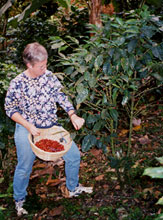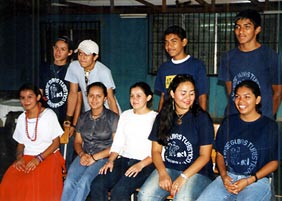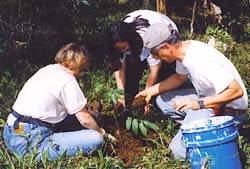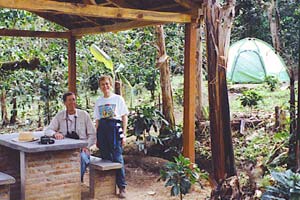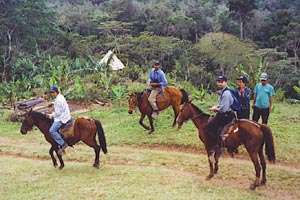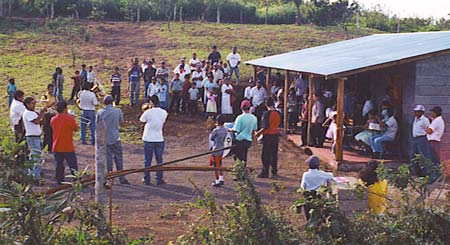|
FINCA ESPERANZA
VERDE Mejor Eco-albergue en Nicaragua, 2004 ABOUT FINCA ESPERANZA VERDE
Description Finca Esperanza Verde (Green Hope Farm) is a cool, green and tranquil paradise located in the lush mountains of central Nicaragua (1,200 m/ 4000 feet elevation - see map). You will find beautiful sunsets, peaceful moments, delicious food, as well as educational and recreational activities. This farm and reserve run by local farmers offers shade-grown organic coffee, rainforest walks with interpretative trails and other natural wonders. Finca Esperanza Verde is a community-based project run by volunteers from North Carolina and an all-Nicaraguan staff. All profits stay in San Ramón, providing a sustainable and environmentally-friendly source of income for local people and resources for community projects. While supporting a rural Nicaraguan community, you can enjoy: Finca Esperanza Verde was founded in 1998 by Durham-San Ramón Sister Communities, a non-profit organization based in Durham, North Carolina (USA). Its mission is to strengthen friendship and cooperation between San Ramón, Nicaragua and Durham, North Carolina through people to people exchanges and social and economic development projects which support justice and our belief in an interdependent, one-world family.
Butterflies are raised by capturing only a couple dozen wild butterflies and keeping them in the pavilion where their host plants for egg laying are cultivated. The pavilion is closely supervised and after the eggs are laid they are removed to screened cages to protect them from parasites and predators. After the eggs hatch into caterpillars, they are fed their host plant's leaves until they pupate. This requires the growing of a large garden of appropriate plants for caterpillar food. Once a month the pupa are collected for export. When visiting Finca Esperanza Verde you may assist in the care of butterfly eggs and caterpillars and the work of gathering their daily diet of leaves as well as preparing pupa for export. The mix of habitats within walking distance and the abundance of species makes the Finca Esxperanza Verde a center for world-class birding. Good trails access most sites, but you should have a local guide to take you those that are more remote. The guides share their enthusiasm for wildlife as well as colorful names and local stories about the species.
Birding groups recorded first official sightings at Finca Esperanza Verde of Yellow Breasted Caracara in 2003 and Streaked Xenops in 2004. Come to San Ramón and help us make history crediting our nature reserve with more official sightings. Click here for the full list of identified birds and wildlife species. San Ramón has 3 climate zones. The farm is located at an elevation of 1,200 meters (4,000 feet) and is classified as "semi-wet tropical" while the town of San Ramón at 750 meters (2500 feet) is “semi-dry tropical” and warmer. Nearby the town are areas classified as “dry tropical” which are much warmer and dryer. Evenings in San Ramón are pleasant and require a sweater or jacket at the farm. Finca Esperanza Verde is located far from the electrical grid. (You'll marvel at the number of stars you can see without the "light pollution" that "developed" areas have.) We have expanded our solar electricity system, photovoltaic or PV system at the lodge to power a couple of refrigerators. In 2003, we funded SuniSolar, a Nicaraguan student engineering group at the national university in Managua, to design and build some prototype, low cost, passive solar hot water heaters for Nicaragua. The prototypes will be installed at the Finca in 2004 for testing, and we will have running hot water for showers. Directions to Finca Esperanza Verde Finca Esperanza Verde is 160 km. from Managua, 30 km. from Matagalpa,
and 18 km. from San Ramón. GROUP TRAVEL
Ecotourist trips to Finca Eperanza Verde and San Ramón are an opportunity not only to enjoy the stunning beauty of the mountainous Matagalpa region of Nicaragua but also to meet local people. On a typical group trip to San Ramón, you will spend four days at Finca Esperanza Verde and three with a host family in town. You will come away with an understanding of what life is like for people in underdeveloped countries and especially the wonderful people you have met.
Your guide will greet you at the Managua airport and escort you to the public bus stop where you are immediately part of the local scene. When you arrive at Finca Esperanza Verde the staff is ready to show you what they have accomplished in developing the farm's lodge and cabins, shade grown organic coffee, butterfly farm and camp ground. Before you can put your bag in your cabin, you will be planning outings to search for leaf cutter ants, howler monkeys, toucans, migratory birds from North America and waterfalls. After dinner you may star gaze, take a hike in search of nocturnal creatures or listen to a talk about organic coffee farming. For those who would like to help out, there is always work to do on the farm picking coffee (December to March), gathering food for the butterfly caterpillars or repairing hiking trails. Local groups come in the evening to sing and to perform traditional dances. On request, local farmers will take you on horseback rides into the countryside.
Durham-San Ramón Sister Communities also has a variety
of ecotourist trips to San Ramón tailored for groups wishing
to concentrate on (follow links for sample itineraries):
Trips planned for 2005 February 5-12: February 19-26: March 5-12 March 12-19: March 26-April 2 Early May Reforestation ecoutours are now forming for June, July and August 2004, 2005. We recently received a 3-year grant to reforest 6 acres of mountain top which was deforested ten years ago by a struggling farmer to grow subsistence crops. During the first 4 days of the ecotour at Finca Esperanza Verde the work project will take up half of each day with the rest of the time devoted to learning about coffee and butterfly production, bird watching, hiking to visit howler moneys, horseback riding and other exotic activities. During the 3 days in the small town of San Ramón the group will participate in an urban forestry project, explore the local culture and live with families. This is a great opportunity for student groups and congregations looking for a significant and fun work project. The all inclusive trip fee excluding air fare per person is: $750 for 7 days in Finca Esperanza Verde and San Ramón. Airfare from the US East Coast ranges from $635 to $750 round trip. The only additional expense is the Nicaraguan entry visa of $5 which you purchase at the airport. If you have enjoyed your trip, we suggest tipping the staff at Finca Esperanza Verde $20-40. The trip fee includes meals, lodging, transportation, and a full schedule of organized activities and cultural performances. The trip price is low because the organizers in the U.S. are volunteers. Ten percent of the trip fee funds water and education projects in San Ramón. In 2002, ecotourism income provided $5000 to build a rural elementary school near the farm, and, in 2003, $6000 for a community built, gravity-fed water system in a coffee cooperative near San Ramón. Reservation form and liability waiver Download the reservation form and liability waiver for our ecotourism
trips: Travel agents that have worked with Durham-San Ramón and Finca Esperanza Verde Mission Travel. Based in Raleigh, NC, but the Latin American division is in Miami. Their number is 1-877-311-7331. Their web site is www.gomission.com. Or email Mary at mary@gomission.com. Chapel Hill Travelink. Phone: 919 942-4196. Their website is www.travelinkonline.com. STA Travel, Santa Barbara CA. Phone: 805-968-515; Fax: 805-893-3562; Email: sba@statravel.com. Speak with Joran or other agents. STA Travel specializes in student/teacher/youth (under 25) discounted flexible airfares. Group trips are organized by volunteer trip coordinators who go for FREE, including a $600 allowance for airfare, when they recruit 10 or more people or earn 50% of their trip cost when they recruit 7 – 9 people to go on an ecotour. Working in the community and service trips All trips include a rich array of activities and interactions with the local community. For those wishing to be of service to the community, here are some suggestions of activities tourists have enjoyed sharing with schools and community groups: - Teach English in small groups to high school students in their
classroom. Bring all equipment and supplies you will need and, when possible, donate them to the school or group you have worked with. Prepare written instructions in Spanish describing how the game or activity is carried out and leave them with the teacher. If you do not speak Spanish, we will try to provide a translator. Activities for individual travelers For an extra charge, a variety of activities are available, including performances by neighboring musicians at our campfire, educational hands-on programs in butterfly farming and shade-grown organic coffee, horseback riding (on farm horses), guided hikes, waterfall excursions, and much more. Don’t forget to bring a jacket (for cold nights), a towel, a flashlight, and walking shoes!!
PROJECTS SUPPORTED WITH ECOTOURISM INCOME 2003: Community built water project for La Pita Coffee Cooperative La Pita community of 250 inhabitants was chosen to receive the 10 % donation of our ecotour income from 2003 and the proceeds of our 10th Anniversary Fiesta for the construction of a gravity fed water project. The community had been trying to get funding for the project for years because their current water supply is contaminated with lead from gold mining operations in the 1900s. The project cost of $16,000 is being shared with Henniker, New Hampshire, also a sister community of San Ramón. The community is providing labor, Programa Agua is providing the plan, training, technical expertise, and delivery of materials. One of the community members deeded the land where the water springs forth from the mountain to the community in perpetuity. Thirty four houses will have their own water spigots; 4 homes located at a high elevation will share a spigot. "I am very happy that I will have clean water coming right to my house so I can have a nice clean shower right at home," Francisco Mendoza, a senior citizen of La Pita. 2002: La ChispaElementary School Not far from the Finca Esperanza Verde, 52 children attend a brand new elementary school that opened in February, 2003. A local farmer donated the land, parents and older brothers constructed the two-classroom building, the Ministry of Education supplied a teacher and desks, and the 10% of our ecotour income for 2002 which we dedicate to a community development project paid for the building materials. Without La Chispa school, all these kids would not be in school or would need to move in with relatives in a different town in order to be near a school.
The municipal band, vice-mayor and proud students and parents inaugurate La Chispa Elementary School. TRAVELER AIDS Medical
information Please consult a travel clinic or your own doctor to inform yourself about your current immunizations and appropriate shots and vaccinations that you may need. You should begin this process as early as possible before your trip. Travel clinics in the Research Triangle are: Immunizations you might want to consider are: Traveler’s diarrhea. To treat diarrhea, have on hand Cipro, a wide spectrum antibiotic, in 500 mg doses. (Cipro is available at the pharmacy in San Ramón @ 35¢ per dose.) To resort to using Cipro to treat your diarrhea, your condition should be bad. One to three doses of Cipro will usually relieve your condition. If the diarrhea is mild, take Pepto-Bismol or try to wait it out without resorting to taking any medication. You should always consume lots of purified water, not eat uncooked vegetables or unpeeled fruit, wash your hands frequently especially before eating, and brush your teeth with purified water. If you go swimming and when showering, don't get water in your mouth. Information from the Center for Disease Control on Central America and Mexico may be found at www.cdc.gov/travel/camerica.htm. Baggage: What to pack: What to leave behind: Other suggestions: Managua airport arrival, departure and customs 1. You will be given a customs declaration on the plane to fill
out. If you have less than $500 worth of stuff to bring into the
country, you do not have to itemize your belongings. Even though
noone will need to list the contents of the suitcase/s he or she
is bringing into the country (assuming the value is under $500),
he or she needs to know what the contents of the suitcase are.
(For instance, if you are carrying suitcases full of material aid
which you didn't pack yourself, open the suitcase ahead of time
and check out the contents.) Contact information for travelers You will be in a rural area with no access to telephones or electricity other than solar power for the first 4 days of our typical week long ecotour. When in the village of San Ramón, you will have access to a public telephone which is difficult to use unless you speak Spanish. There are cybercafes in Matagalpa. Emergency contact numbers for our office and home of Yelba Valenzuela: Upon your arrival, an email will be sent to the emergency email address listed on your trip reservation form announcing your safe arrival. Recommendations for all travelers Local Customs and Courtesy towards rural people: Photography: Tips: Guest House families: Begging: - "Ecotourism and Sustainable Development: Who owns Paradise?" by Martha Honey. Island Press. 1999. ISBN: 1-55963-582-7. Overview of the ecotourism industry and a first-hand account of ecotourism projects around the world. Vivid descriptions and analysis of projects that meet the goals and standards of ecotourism as well as those that claim to be ecotourism but in reality fall short. In-depth case studies of seven destinations. - "A Guide to the Birds of Costa Rica," F. Gary Stiles and Alexander F. Skutch, Comstock Publishing Associates (a division of Cornell University Press), Ithaca, NY, 1989.There is no one bird field guide that contains all of the birds a person might see in Nicaragua (or at least, if there is, we didn't find it). One person in the group should bring this one. Someone else should bring the next one: - "A Guide to the Birds of Mexico and Northern Central America," Steve N. G. Howell and Sophie Webb, OxfordUniversity Press, New York, 1995. Like the above title, an excellent field guide. Every bird we saw occurred in this book or the previous one. Many species are found in both. If you are a hard-core birder, buy both titles. They are pretty fat books for field guides, though. You don't want to carry both in the field. So share. -"A Neotropical Companion: An Introduction to the Animals, Plants, & Ecosystems of the New World Tropics," John Kricher, PrincetonUniversity Press, Princeton, NJ, 1997. Not everything in the book above relates to things folks will see in Nicaragua, but it does provide an entertaining and readable introduction to that part of the world through the eyes of an ecologist. This is a good book to get from the library. Read the chapters that sound most interesting as background for your trip. -Nicaragua In Focus: A Guide to the People, Politics and Culture. Hazel Plunkett. Interlink Books, 1999, 2002. Brief and insightful. - Nicaragua.com: a portal
covering business, community, travel, culture, news, sport, weather,
etc. The International Ecotourism Society The International Ecotourism Society defines ecotourism as "responsible
travel to natural areas that conserves the environment and improves
the well-being of local people." This means that those who
implement and participate in ecotourism activities should follow
the following principles: Finca Esperanza Verde awards Smithsonian Magazine Awards $20,000 Sustainable Tourism Award to Nicaraguan Eco-Lodge Launched by North Carolina Volunteers DURHAM - Finca Esperanza Verde (Green Hope Farm) Eco-lodge and Nature Preserve, created out of an abandoned coffee farm in the mountains of central Nicaragua by a Durham, North Carolina non-profit organization and their Nicarguan partners, has won a $20,000 Sustainable Tourism Award for Conservation from Smithsonian Magazine and Travelers Conservation Foundation in a worldwide competition. The winners will receive their award at the USTOA conference in Hollywood, Florida, on December 6, 2004, and will be highlighted in SMITHSONIAN MAGAZINE. The Durham organization, Durham-San Ramón Sister Communities, joined by Nicarguan partners have been developing a tourism operation in the rural mountainous county of San Ramón, Nicaragua since 1998. Durham volunteers created the sister community relationship in 1993 in an effort to relieve persistent unemployment and poverty in one of the poorest nations in the Western Hemisphere. The project includes: Finca Esperanza Verde was named Best Eco-Lodge in 2004 by the Nicaraguan Institute of Tourism. The Nicaraguan Minister of Tourism, Lucía Salazar, who launched a nation-wide campaign to encourage Nicaraguans to vote in the Smithsonian Magazine on line competition said, "It is the first time Nicaragua is the winner in a world wide competition. The Sustainable Tourism Award for Conservation bestowed on Finca Esperanza Verde Ecolodge and Nature Preserve gives a positive image to our country currently promoting itself as a tourist destination, especially with European and North American tourists who usually seek destinations friendly to the environment. This is an excellent opportunity to let people know about our country. The award will help to change the negative image that we have, it will attract more tourism which will permit the creation of more employment and it is of immense pride for Nicaragua." Finca Esperanza Verde Eco-lodge, built of handmade brick with solar electric panels on all the roof tops and two solar refrigerators in the kitchen, has a 100 mile view across the Dariense mountain range. It is a cool, green and tranquil paradise at 1,200 meters/4,000 feet elevation. From the 18 bed lodge visitors may bird watch while seated in a rocking chair or stroll through nearby hiking trails to view 150 species of birds and other wildlife. The lodge includes two cabins with bath and shower which each sleep six people in comfortable bunk beds and three private rooms with shared bath and shower. There is an 8 bed dormitory located next to the butterfly farming operation nearby. Eco-tours to San Ramón are organized by former tourists who want to introduce others to rural Nicaraguan where a casual horse back ride can turn into an opportunity to visit the horse owner’s farm to meet his family. And where a hike through the shade grown coffee farm can turn into a lesson in how to cure rashes and stomach ache with herbal medicines growing along the path as well as a dip in a secluded pool below a waterfall. None of the revenues from the eco-tours is taken out of San Ramón. It goes to local community development projects, to support the farm and to pay for a broad array of services including home stays with local families. In addition, ten percent of the income from eco-tours is donated to a community to build a school or water project. Recent eco-tour groups from the Triangle area include scientists from the NC Museum of Natural Sciences, members of the NC Audubon Society, returned Peace Corps volunteers, Southwest Durham Rotary Club, DurhamAcademy, RaleighCharterHigh School, and EastChapel HillHigh School. Educators consider a week’s visit to the farm and town of San Ramón a unique opportunity for their students to live with a Nicaraguan family, to speak Spanish and to teach their Nicaraguan peers some English. The eco-lodge is the centerpiece of an expanding network of projects in San Ramón funded by Durham-San Ramón Sister Communities and the organizations and individuals that support it. Finca Esperanza Verde has strong ties with the Museum of Life and Science in Durham, which has imported butterfly pupa raised on the farm and leaf cutter ants for the museum’s well-known Butterfly House. The Southwest Durham Rotary Club has donated over $100,000 to community development projects in San Ramón over the past 10 years, including $50,000 to build a new water system for the urbanized area. In addition, projects including a free music school, sports programs for children, a high school teacher’s salary, a librarian’s salary, an activity program for senior citizens, art classes for youth, adult literacy program, a physical therapist for the handicapped children’s center, and a sports program and medical equipment for the health center have been funded by Durham congregations including Eno River Unitarian Universalist Fellowship, Watts Street Baptist Church, Duke Chapel Congregation, and Durham Friends Meeting, as well as other organizations and individual donors. The project has prompted villagers to become entrepreneurs, launching micro-enterprises such as cooking classes on local dishes wrapped in banana leaves, workshops where tourists turn a pile of tropical seeds into attractive necklaces, a network of guest house families, and Nicaraguan folk music groups. The income is quickly converted into new shoes for school, musical instruments, and improved health care. Two of the founders of the sister community partnership, Richard and Lonna Harkrader, lead eco-tours to San Ramón every year when they have the opportunity to bring the challenges of life in a poor area of the world into sharp focus for the eco-tour participants. Richard, an architect and renewal energy promoter, designed the all buildings at Finca Esperanza Verde including the butterfly house. Both were Peace Corps volunteers in Africa in the late 60’s and own and rent passive solar apartments with solar water heaters in Durham. The ongoing hope for eco-tourism in San Ramón is to protect the mountains from deforestation through increased appreciation for the economic benefits eco-tourism brings. The words of Ernesto Gonzalez, naturalist guide at Finca Esperanza Verde, are a perfect expression of this attitude shift, "When I first started working at Finca Esperanza Verde, I was like other farmers around here in my lack of appreciation for the natural world. I would whack into trees with my machete as I walked along to pass the time just like all the rest. Now I have changed. The tourists and natural scientists who have come to San Ramón have shown so much respect and fascination for the natural world I used to take for granted, that now I, too, value the wildlife and plants around me. It is like a new world before my eyes. And the income I make as a naturalist guide, which I have been trained to be thanks to this project, helps my family have a better life." The Smithsonian Magazine/Travelers Conservation Foundation contest is detailed in a press release at http://www.sustainabletourismawards.com Other contacts: FOR IMMEDIATE RELEASE: November 22, 2004 CONTACT: Lonna Harkrader, 919 489-1656 Finca Esperanza Verde triples its size! In July 2004 Durham - San Ramon Sister Communites (DSRSC) received a loan to purchase the adjoining 100 acre (57 manzana, 50 hectare) rundown coffee farm at the entrance to the Finca Esperanza Verde. This parcel includes the headwaters of the 3 creeks on the Finca. This land will require extensive investment to remove neglected coffee bushes and exotic plants, repair erosion and reforest with appropriate trees to improve habitat for the many birds and monkeys. This fall DSRSC is launching a major $100,000 fundraising appeal for this purchase and another smaller, totally deforested adjoining parcel. Other Finca Esperanza Verde awards - Best Ecolodge in Nicaragua 2004, awarded by the Nicaraguan Ministry
of Tourism and Fodes Tur as part of the Central American Green
Initiative, a Central American wide accreditation program. |
|||||||||||||||||||||

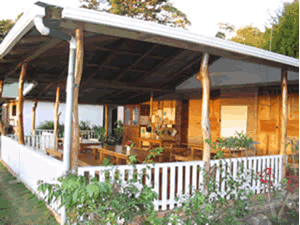
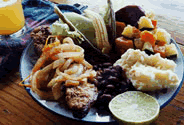
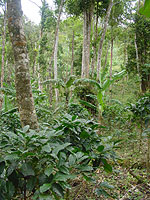
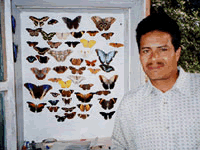
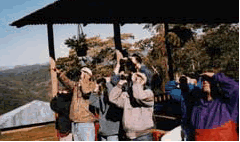
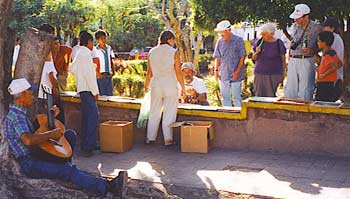 Trips
for groups originating outside Nicaragua
Trips
for groups originating outside Nicaragua